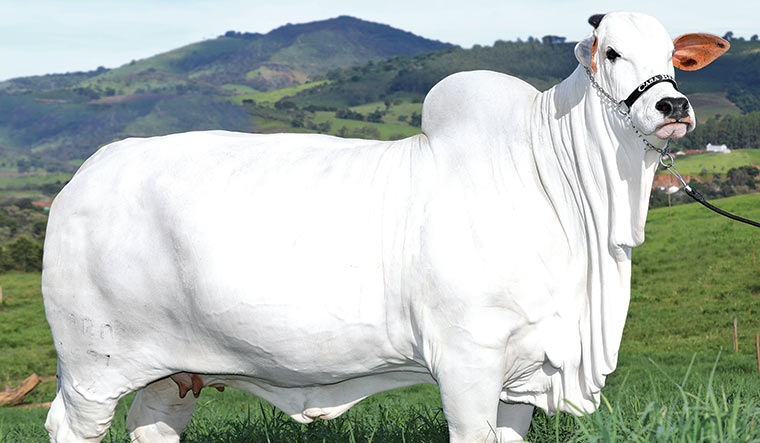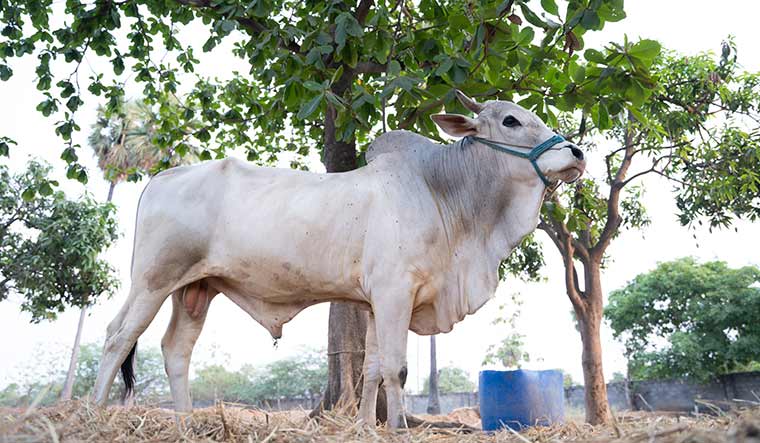Cart (0)
No products in the cart.
The cow is named Viatina-19 FIV Mara Imoveis
 Her majesty: Viatina-19 FIV Mara Imóveis, the Nelore cow in Brazil valued at Rs36 crore | courtesy Casa Branca Agropastoril
Her majesty: Viatina-19 FIV Mara Imóveis, the Nelore cow in Brazil valued at Rs36 crore | courtesy Casa Branca Agropastoril In the annals of livestock breeding, the sale of a single white Nelore cow in Brazil last year was a watershed moment. At an auction held in the central Brazilian town of Nova Iguaçu in Goiás state, one-third of the ownership of this Nelore cow was sold for $1.44 million, propelling her total valuation to an incredible $4.3 million (Rs36 crore). The price tag, certified by Guinness World Records, makes the cow the planet’s most valuable cattle specimen.
The cow is named Viatina-19 FIV Mara Imóveis, and she represents the leading edge of biotechnological innovation revolutionising the global cattle trade. While Nelore bulls regularly fetch prices close to $2,000, there are specific reasons why a cow of the same breed was sold for such an astronomical sum. The bulls are typically sold for their meat and reproductive capabilities, but the value of Viatina-19 lies squarely in her impeccable genetics and pedigree.
Viatina-19 has Indian lineage. The Nelore breed, known scientifically as Bos indicus, is descended from the Ongole cattle of Nellore district in Andhra Pradesh. Ongole cattle are known for their exceptional ability to endure scorching heat and drought-like conditions, and have been revered for centuries as sacred beings.
Both Ongole and Nelore are part of the cattle subspecies called zebu. It was in 1868 that zebu cattle first arrived on Brazilian shores―two bulls and two cows of the Ongole breed made the 13,000km voyage from Nellore to Brazil’s vast and pastoral Bahia state, as per the trade book Cattle Husbandry in India. The cattle were made to cross continents so that they could mix with the milk-laden Dutch breeds, begetting a cross that could better withstand the bugs that thrived in the warm Brazilian climates.
Zebu reinforcements arrived sporadically over the next decade, injecting Indian bloodlines into Brazil’s fledgling herds. A major influx of 100 Ongole cattle in the 1960s truly established the breed’s dominance in Brazil. Over generations, the Indian zebu’s mystique was absorbed into the rugged ethos of the Brazilian gaucho, the iconic cowhands who shaped the nation’s cattle culture.
Today, gauchos see themselves as gentlemen custodians of a breed with an almost mythical lineage, and whose cultural oeuvre is spread across Brazilian hinterlands. The city of Uberaba, for instance, has become a veritable “Zebu capital”, housing zebu restaurants, industry bodies and zebu labs, and hosting zebu expos.
 Nelore cattle on a farm in Brazil | Shutterstock
Nelore cattle on a farm in Brazil | Shutterstock Through biotechnological innovations, the ranchers are now optimising zebu cattle for the future. “Zebu genetics is one of the main tools for [bringing] sustainability,” said Gabriel Garcia Cid, president of the Brazilian Zebu Cattle Association and a descendant of one of the first Brazilian ranchers to import cattle from India in the 19th century.
Nelore cattle have become the bedrock of Brazil’s cattle industry. They comprise a staggering 80 per cent of Brazil’s 225 million herd, and are present across Brazil’s diverse ecosystems, from the scorching Caatinga shrublands to the humid environs of the Amazon basin. The country’s prowess in cattle breeding―Brazil is the world’s largest beef exporter, with exports worth more than $8 billion in 2022―owes a lot to the high-endurance, low-maintenance Nelore cattle.
“I believe the record price reflects the success of the Brazilian scientists who have produced this valuable cow,” Suresh Reddy, India’s ambassador to Brazil, told THE WEEK. “It is also a matter of pride that the roots of this cow, and of Nelore cattle in general, are traced back to India, again reflecting the historical connect between our two nations.”
Pedigree apart, Viatina-19’s genome encodes a constellation of ideal traits―heat resistance, disease immunity, feed efficiency, high-quality marbling, and prolific reproductive vigour. Thanks to modern biotechnological processes like embryo transfers, in vitro fertilisation and cloning, her genes can be passed on on an industrial scale. While an ordinary Nelore bull can sire just a few dozen calves, this “queen” cow can spawn entire herds of optimised, sustainable, and highly productive cattle. With global demand for bovine meat projected to grow by 35 per cent over 20 years, Viatina-19 represents a “billion-dollar jewel” in the marketplace.
This is not the first time that Viatina-19 has set a record. Two years ago, half of her ownership rights had been auctioned for a record $8,00,000 (Rs6.7 crore). The same share is worth a cool $2.15 million after the latest transaction.
Nelore cattle are so desirable for Brazilian ranchers mainly because of their remarkable ability to thrive in tropical climates. The Ongole cattle, which calls the dry and often arid Deccan Plateau home, were built to endure scorching heat and drought-like conditions. The Nelore breed’s signature traits include a bright white coat of fur, thick and loose skin that aid heat dissipation, and a characteristic hump that helps them store energy and survive environments that the more delicate European cattle breeds would find punishing.
 All in the family: A specimen of the Ongole cattle in Andhra Pradesh, from which the Nelore breed is descended | Satyanarayana Gola
All in the family: A specimen of the Ongole cattle in Andhra Pradesh, from which the Nelore breed is descended | Satyanarayana Gola Also, the Nelore breed’s evolutionary journey has fortified it against a barrage of tropical diseases and parasitic infections that have plundered foreign cattle stocks. Their exceptional disease resistance, honed over centuries, helps Nelore cattle shrug off maladies that would cripple weaker breeds.
In the early 2000s, the Brazilian cattle industry launched a campaign promoting Nelore as Boi ecológico or ‘ecological ox’―a breed uniquely suited to sustainable beef production. The logic was simple: Nelore cattle could thrive on poor-quality forage, reducing the need for land conversion and feed cultivation. Their greater muscle mass meant more beef produced per head, theoretically minimising the environmental footprint.
The Boi ecológico marketing blitz has faded, with researchers realising that Nelore’s carbon footprint was no greener than of other breeds. But the pursuit of sustainability remains a core driver of Brazilian cattle breeding. In the quest to create a ‘greener’ cattle stock, Nelore’s genetic repository holds immense potential. Breeders have been meticulously selecting traits that increase feed efficiency, reduce methane emissions, and optimise meat production―a feat that could redefine the environmental economics of cattle ranching. The trio of breeders that now own Viatina-19―Casa Branca Agropastoril, Agropecuária Napemo and Nelore HRO―have vowed to widely disseminate her genes, accelerating the breed’s evolution.
“Viatina-19 symbolises the superior quality standard we seek, and her recognition from the Guinness World Records is proof that an investment in genetic excellence provides returns, whether in differentiated products, financial gains or prestige,” said Fabiana Marques Borrelli, director of Casa Branca Agropastoril.
According to Garcia Sid, breeders realise the importance of bringing genetic improvements. “The preservation of natural resources is fundamental for the future of livestock farming,” he said. “The cow’s new owners, Nelore HRO, have expressed their excitement and commitment to sharing Viatina-19’s genetics, indicating the potential for further advancements in the breed’s quality.”
Genetics now plays a pivotal role in Brazilian cattle ranching. Long gone are the days when herds were left to breed haphazardly; today, the process is a science, with cutting-edge reproductive technologies amplifying desirable traits at an astonishing pace.
At the forefront of this change are entities like Bioembryo, a leading bovine reproduction laboratory at Cuiabá in Mato Grosso state. At Bioembryo, ovaries from champion donors like Viatina-19 are meticulously assessed, with each ovule scrutinised under a microscope to identify the ripest, most viable eggs. The selected eggs are then fertilised with semen from elite studs, generating embryos preordained for genetic excellence. The procreation process itself has been revolutionised, with breeders surgically transferring embryos into surrogate mothers to avoid the hassles of natural conception.
Cloning, too, has become a staple tool. At Geneal Laboratory, one of Brazil’s premier bovine cloning facilities, around 70 cloned calves are born every year. These reproductive technologies allow breeders who invest millions in cows like Viatina-19 to exponentially amplify the value of the genetic assets they own.
But, for all the triumph surrounding Viatina’s record sale, storm clouds loom over Brazil’s cattle horizons. Environmentalists have long blamed the ranching industry for being the prime driver of deforestation in the Amazon rainforest, one of the world’s most precious carbon sinks. Over the past 60 years, nearly a fifth of Brazil’s rainforest cover has been razed to make way for cattle pastures, a trend exacerbated by unscrupulous ranchers operating on illegally cleared indigenous lands.
The meteoric growth of zebu herds has only intensified the environmental pressures. While resilient and resource-efficient, the flatulence and belching of zebu cattle contribute a sizeable 14.5 per cent of all global greenhouse gas emissions. Every year, a single cow can emit more than a hundred pounds of methane―a greenhouse gas far more potent, though less lasting, than carbon dioxide.
President Luiz Inácio Lula da Silva has vowed to curb deforestation, but the sheer economic might of Brazil’s beef industry could make grand proposals easier to proclaim than to actually execute. As the demand for beef surges alongside the increasing wealth in developing nations, limiting the environmental toll of cattle production has become an existential priority.
A path forward could be ‘green’ cows, which could drastically reduce the industry’s environmental footprint without compromising on productivity. Brazil’s proud ranchers, in a way, are betting the farm on Viatina-19. “The global recognition of Viatina-19,” said Borrelli, “elevates the prestige of Brazilian cattle ranching, and solidifies its status as a world-class genetic icon.”
Credits : www.theweek.in
Share: